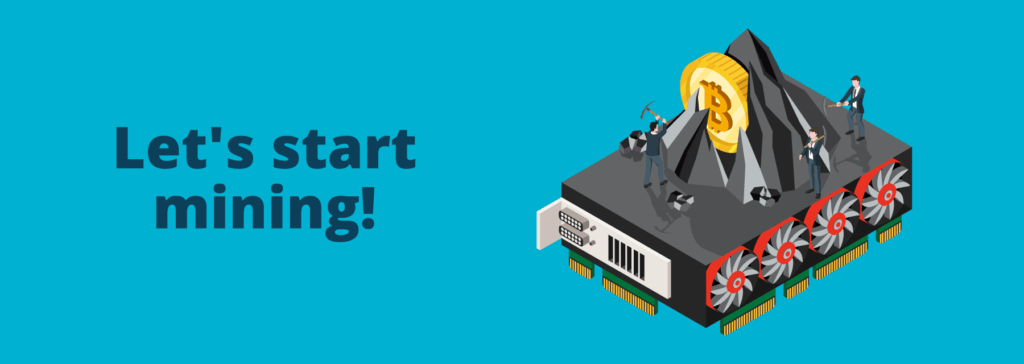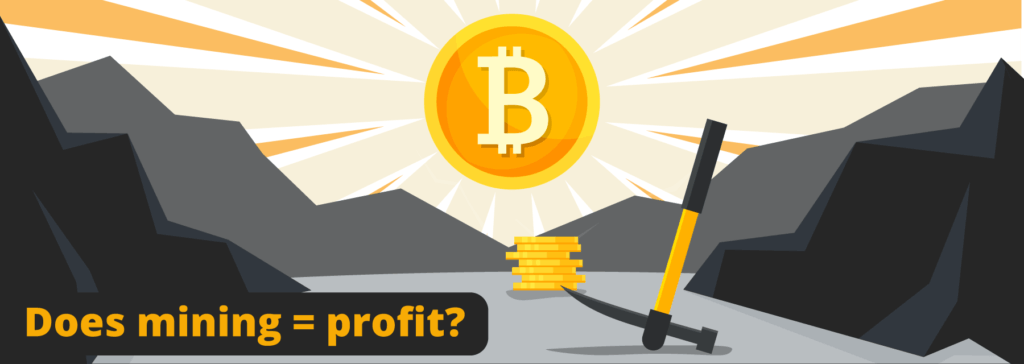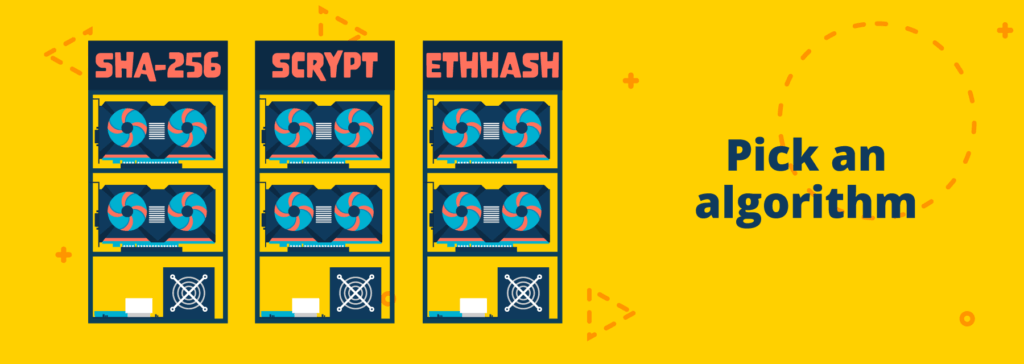How to mine Crypto
Cryptocurrency mining gives everyone a chance to get involved with their favorite cryptos.
But not everyone knows where to begin.
So, CryptoMeister is going to teach you everything about cryptocurrency mining to help you become a mining pro!
Whether you’re already a crypto miner or are looking to get started, we’re sure that we can teach you a thing or 2!
Hold on to your hats, we’re heading down the mines!
The complete guide to cryptocurrency mining

Before you dive into the world of cryptocurrency mining, there are many aspects that you need to assess.
There’s a misconception whereby people think that you will instantly make money if you are mining crypto.
But that’s not the case at all.
A lot of hard work needs to be done during the planning and setup phase if you’re going to make it in the crypto mining game.
You need to think about which algorithm you’re going to mine, which currency you’ll mine, the hardware you’ll use, your power source and more.
It’s not quite as simple as plugging in a box or running a program on your computer.
But, that’s why CryptoMeister is here.
We’re going to strip out all of the confusion and explain how you can mine cryptocurrency from your very own home – and hopefully do it profitably too!
What is cryptocurrency mining?

When people talk about cryptocurrency mining, they’re not talking about heading down an actual mine with a bunch of dynamite and a canary.
Crypto mining is the process of completing complex mathematical equations in a bid to squish all of the data required into a hash.
This data is the transactions that are sat in the mempool.
These blocks are also limited in size, for the most part, so miners have to pick and choose transactions to go in the next block when they are doing the math.
It’s more profitable for the miners to pick the transactions with the highest fees, so they usually include transactions based on fee size.
Then, once a miner has solved the puzzle, the transactions will be wrapped neatly into the block and pushed to the blockchain.
Nodes then do their job and distribute this new block around the globe and allow the blockchain to propagate.
Mining is only done on Proof-of-Work (PoW) blockchains.
As the name suggests, the work is the computers putting in the time and energy to create the hashes in order to solve the puzzle.
How these computers and machines work is fairly complex, but unless you’re going to build your own mining software then it’s not necessary to understand it.
Different PoW blockchains will use different algorithms for mining.
The algorithm is essentially used to hash and authenticate blocks of transaction data.
SHA-256 is the most common mining algorithm and is fully encrypted.
SHA stands for secure hashing algorithm and 256 is the number of bits it creates.
The more bits, the more secure.
The algorithm will take an input and run it through the hashing algorithm.
The same input will always create the same output.
But the output cannot be run through the algorithm to get the input – it’s a 1-way system.
Different algorithms work at different speeds, with the faster ones being more insecure.
As a result, wallets will require more blocks to pass from the moment your transaction is added to a block before it counts as a valid transaction.
To put this into comparison, SHA-256 will complete a block every 6-10 minutes, while Scrypt can find a block in around 30 seconds.
All algorithms have one thing in common – the higher the mining difficulty is, the more hash rate is required to find the next block.
This in turn creates its own problems, as you’ll often see with less popular blockchains.
For example, in the early days of Dogecoin, miners wouldn’t stay connected to the network 24/7.
When miners disconnected from the network, the hash rate would drop significantly.
As a result, there wouldn’t be enough hash rate to find the next block as the difficulty hadn’t adjusted.
So, to solve this problem, DigiByte, another PoW blockchain, developed a feature known as DigiShield.
DigiShield allows the mining difficulty to adjust after every block.
Block stalling was so common in the early days of PoW blockchains that more than 20 other blockchains have implemented it.
The following blockchains use DigiShield to adjust mining difficulty after every block:
The more people that are mining cryptocurrency, the more secure the network becomes.
If one miner controls 51% or more of the total hash rate, they’re known as the dominant miner.
This gives them almost total control over the blockchain and can do anything they want.
Whether it’s rewriting old blocks, minting new coins, double spending, or even destroying the blockchain, it can all be done by 1 miner.
As a result, blockchains are constantly looking to become what’s known as ASIC-resistant.
This allows more people to mine with a lower cost of entry.
But more on that shortly!
Why do people mine crypto?

Anyone in the world can get involved with crypto mining on some level.
But why do people do it?
Is it for the money, the blockchain, or because they just like technology?
Well, for the most part people mine cryptocurrency to make money.
Running your computer or an ASIC mining rig 24/7 will consume a whole bunch of electricity, sending your bills through the roof.
You’ll also wear out hardware at a faster rate than if you used it normally.
All of this means one thing – you need a lot of money to survive.
The advantage of Proof-of-Work (PoW) blockchains is that when you find a block, or are involved in finding a block, you get rewarded.
You’ll get the total of the transaction fees from the block as well as a block reward.
The block reward is set by the blockchain’s core code and will often halve every so often.
The fees are the transaction fees that you pay to send your transaction.
Now you know why miners will prioritize transactions with higher fees – they make more money.
If you set up your crypto mining operations properly, you can make a lot of money.
Obviously, every cryptocurrency has a minimum viable profitability price and it’s different for each currency.
For example, the average lifetime cost of an ASIC mining rig to mine 1 Bitcoin is $15,000 – $19,000.
As long as Bitcoin remains above that price, it’s profitable.
If Bitcoin falls below that price, then you’ll potentially be running at a loss.
Now, crypto miners often attempt to manipulate the market price by either holding onto newly minted coins or flooding the market with them.
When the network hash rate climbs too high because a certain crypto is incredibly profitable to mine, large miners will flood the market with coins.
This will lower the price of that cryptocurrency and cause the new miners to divert their power elsewhere.
On the other hand, if the price is falling below the break-even level, big miners will stop selling their new coins.
This will reduce the supply and shore up the price.
The reality of the situation is that people don’t mine for the fun of it or to help the network out.
They mine cryptocurrency to make money.
There are a few that break the trend, but for the most part, people mine for profit.
Can I make money mining cryptocurrency?

Now we’ve learned that people really only get into crypto mining for the money, it’s time for the million-dollar question – can I make money mining crypto?
The short answer is yes, yes you can.
But there’s a lot more to it than loading up an app on your computer or buying an ASIC rig from the internet.
You have to take a ton of factors into consideration, and the choices you make will impact your profitability.
As we explored in the previous section, cryptocurrencies fluctuate in price, you can end up mining a coin that’s not presently profitable to mine.
So, rather than picking a currency to mine, you should look at algorithms instead.
Not all hardware can mine the same algorithms, so if you’re going to invest upwards of €2,000 in an ASIC mining rig, pick one that gives you lots of options.
Picking the right algorithm

So, now you know that picking an algorithm is actually more important than currency, you’re part of the way to becoming a profitable crypto miner.
But how do you pick profitable algorithms?
There’s a neat tool called ASIC Miner Value.
The landing page lets you see the most profitable mining rigs and what algorithms they mine.
Currently, the most profitable rigs available to purchase let you mine Blake256R14.
The top 2 rigs both mine this algorithm, and this algorithm alone.
Next, you’ll want to see which cryptocurrencies use that algorithm.
Only Decred uses Blake256R14, so if its value falls too low, you have no other cryptocurrencies to mine.
While this would be a short-term profitable algorithm to mine, there’s no telling if any other cryptocurrencies will ever use Blake256R14.
This limits your options and puts you in a tight corner.
Ethhash is another top algorithm, but it’s used to mine Ethereum and Ethereum only.
For the time being, that’s not a bad option, but Ethereum is transitioning away from Proof-of-Work in Ethereum 2.0.
There’s no launch date for Ethereum 2.0, but if you’re going to drop €5,000 on a mining rig, you want to know that it will be useful for at least a year.
Generally speaking, in terms of versatility, the best 2 algorithms to look at are SHA-256 and Scrypt.
There are thousands of coins using these 2 algorithms, which gives you plenty of pivot potential should one take a nosedive.
The Antminer L7 is a Scrypt rig and is set to launch in November 2021.
With electricity costing €0.13 per KWh, you’ll earn €93.61 per day at current coin prices.
It will cost around $13,000 brand-new, but you’ll break even at the 4-month mark, should prices remain as they are.
You’ll break even sooner if prices continue to rise.
Best of all, with Scrypt and SHA-256, if a coin that you’re mining tanks in price, or one breaks from the crowd and moons, you can divert your power to another coin at the click of a button.
This allows you to fine tune and maximize your mining strategy.
Sort out your electricity

The next biggest factor in becoming a profitable crypto miner is sorting out your electricity cost.
Obviously the lower the cost, the more you’ll make from mining.
But don’t go bypassing the grid and steal electricity.
Miners in China have been caught stealing electricity from the rail networks, which landed them in jail – so don’t do that.
If you live in a region with access to cheap, green, and renewable energy, you’ll end up being the most profitable.
This is a major reason a lot of the “smart” crypto miners are setting up their farms in areas of the world that use hydroelectric power.
Washington State is a hotbed for crypto mining activity for this reason.
Elsewhere, Canada is growing in popularity thanks to the abundance of natural gas and Iceland is popular thanks to its geothermal power plants.
The low electricity cost reduces the average cost to mine 1 coin, which increases the overall profit.
You might not be able to negotiate a better deal with your power company, but installing solar panels, wind turbines and hydroelectric turbines can help reduce your cost.
One mining firm bought an old hydroelectric dam and refurbished it, making it the ultimate crypto mining farm.
The bottom-line is don’t steal power and try to use renewable energy where possible.
You’ll make Greta Thunberg happy!
How can I mine crypto?

Now you’ve got a bit of an idea of what goes into mining, it’s time to learn how to start mining.
You need to make your decisions on the algorithm that you wish to mine and which coin from within that algorithm that you’re going to focus on.
Then, set about building your mining farm.
Whether you’ll build custom rigs using GPUs and gaming motherboards or buy ASIC rigs, you need something to mine on.
Setting these up can be a little tricky, so if you’re not great with technology, try to get a rig that comes pre-built.
Once the rig is all ready to go, you’ll need to connect to it.
You can do this using your local network or connecting via the network port on the rig.
Once you’re talking to the rig with your computer, you’ll need to tell it what to do.
You’ll have to tell it which cryptocurrency you want to mine, which pool you want to join (in the case you want to join a pool), and where to send the rewards.
It’s advisable to join a pool as you’re more likely to find a block and earn rewards that way.
Pools work by combining the resources and power of miners from around the globe to mine one cryptocurrency.
When a block is found by the pool, the rewards are split between all the miners in the pool in proportion with the amount of hash rate provided by each miner.
A pool fee is taken off the top as a sort of admin fee.
The output address is the wallet where you want to store your cryptocurrency rewards from mining.
You can use any wallet address that supports the currency that you’re mining.
Once you’re happy, you can connect to the pool and start mining.
Most mining rigs will come with instructions, so it’s advisable to follow those if you’re unsure what to do.
This process is a little different for every single mining rig and software.
So don’t be afraid if it’s not exactly as we explained here, it could be a little different.
When you’re planning your crypto mining empire, you’ll need to consider what sort of mining you want to do.
We’ll run through the options now.
Your own hardware

When people think of crypto mining, they think of hardware running in a basement somewhere.
And for the most part, that is the true essence of crypto mining.
Most miners will buy their own hardware, set it up, maintain it and reap all the benefits.
This is the “cheapest” solution in terms of ongoing fees.
You will need to be able to repair the rigs and troubleshoot them should something go wrong.
Downtime is less time mining and less profits, so time is of the essence here.
Police also confuse crypto mining farms at private residences with cannabis grows.
So, if you are going to set up a crypto mining farm at your address, have a chat with your local police department and give them a tour.
This will prevent any unwanted visitors from smashing down your door.
It has happened many times before and it will happen again.
You’ll also need to consider cooling as crypto mining rigs get hot.
The hotter they get, the less efficient they become.
A good AC system should help regulate temperatures.
Virtual machines

If you are going to mine a cryptocurrency that can be done on a computer, but you don’t want to use your own machine, you could consider a virtual machine.
Instead, you can rent a virtual machine.
This is essentially a server somewhere else in the world that acts like a computer.
You can use it for the same tasks as a normal computer, but if you get a high-end virtual machine, you can mine crypto on it.
You won’t have to take care of maintenance or internet connection as the virtual machine provider will do all that for you.
You simply pay the monthly bills to keep it running.
The only drawback is the cost of a virtual machine required to mine crypto at scale isn’t cheap.
Scripts/crypto jacking

Not all cryptocurrencies need powerful mining rigs to be mined, and some can be done using a small amount of your CPU or GPU power.
In steps the crypto mining scripts.
These are tiny little scripts that run in the background on your devices.
Many websites are starting to implement them in the background or instead of ads.
Once you load up a site with one of the scripts, it’ll begin sending packets to your computer and your computer will start solving the requests.
What your computer is doing is creating hashes to mine particular cryptocurrencies.
Monero is a popular cryptocurrency to mine using this method.
Some websites have also fallen prey to hackers that inject these scripts into their sites.
This is known as crypto jacking.
Unfortunately, it’s not just websites that can fall prey to these types of attacks.
Hackers have been known to inject them into routers, meaning that every device that connects to it will begin mining crypto in the background.
The hackers can then decide what percentage of your CPU and GPU is diverted to their mining.
Wise hackers keep the rate low so that you don’t notice it, but some will crank it up to the max.
It’s becoming a major issue, and internet service providers have been issuing guides on how to detect it.
In India, more than 30,000 MikroTik routers have been infected with crypto jacking scripts.
So, keep your routers up to date and use an ad blocker where possible.
These block the scripts that run the mining scripts.
If you want to use them for good, you can pop them on your website and leave a notice that explains what you’re doing.
Several websites have tried this method in favor of ads, including the likes of Pirate Bay.
Cloud mining

Finally, we come to cloud mining.
Cloud mining has a terrible reputation thanks to scammers abusing it.
Cloud mining is where you rent out ASIC mining rigs from a company and they handle everything else.
The company will handle the purchase, setup, and maintenance of these rigs for the duration of your contract.
This is a quick, easy and simple way to mine cryptocurrency, but it’s also dangerous.
Many cloud mining companies are scams, and you’ll never see a cent from them.
Others are poorly set up and will run at a loss for you as the renter.
In some parts of the world, cloud mining contracts are illegal.
For example, in Texas, it’s forbidden to sell cloud mining contracts, but companies still try to do it anyway.
There are many scammers in the cloud mining world, so treat cloud mining with a healthy dose of caution.
If it sounds too good to be true, it usually is.
Can I mine crypto for free?

Specialist crypto mining hardware can cost an absolute fortune, and you might not be ready to drop that kind of investment just yet.
That’s totally fine and normal.
After all, it’s a major investment that could potentially backfire.
If cryptocurrency markets crash and become unprofitable to mine given your hardware and cost of electricity, then you’re stuck.
Or perhaps your hardware fails after 6 months.
Both of these are very reasonable and realistic scenarios that could leave you out of pocket.
So, what about testing the waters and mining crypto for free?
Is it possible?
Well, yes and no.
There are ways that you can mine cryptocurrency for free, but it’s not a true representation of crypto mining.
What we mean by this is that sure, you might earn a few satoshis, but it won’t be anything significant.
Also, the experience will be vastly different from having your own crypto mining setup.
Free crypto mining is done through apps and games, rather than hardware.
There are some crypto mining simulator games out there that let you play fun games and earn in-game hash rate.
You then direct that to cryptocurrencies in-game and at the end of the day, you’ll get some actual cryptocurrency as a reward for your progress.
In reality, this is just a cut from the ads that you’ll have watched throughout your session, not real crypto that you’ve mined.
But, this type of game does give you the “experience” and “taste” of mining crypto.
On the other hand, there are a few cryptocurrency exchanges that will allow you to mine crypto for free.
These exchanges, however, offer it as more of a rewards program than an actual free crypto miner.
Under these programs you’ll be allotted a certain amount of hash rate based on how much trade volume you have.
In reality it’s more of a frequent trader rewards program.
All other “free” crypto miners will use your CPU or GPU.
In these cases, you’re better off downloading actual mining software, joining a pool and mining that way.
These free-to-use crypto mining sites will take a large cut of anything that’s ever found, making it not worth your time.
So, if you want to count playing games and rewards programs as free mining, then yes, you can mine crypto for free.
Which is the best algorithm to mine?

There are lots of different algorithms out there that you can mine, but some are better than others.
As we discussed earlier, having the ability to swap between coins is crucial to being a profitable crypto miner.
So, look for algorithms that have powerful ASIC mining rigs and a good number of coins using it.
SHA-256 and Scrypt are 2 of the better choices out there based on these conditions.
There are thousands of coins using both of these algorithms, meaning that you’ve got plenty of pivot potential should a coin tank.
New ASIC miners are produced regularly for these 2 algorithms as well.
This means that there’s still potential for these algorithms and that manufacturers see there’s a need for this type of hardware going forward.
That being said, sometimes the latest isn’t best.
The best Scrypt mining rigs are currently 3 years old.
They pack the biggest and best punch, which allows you to enter the Scrypt mining space at a lower cost.
Lower cost means less time until you’re making profits from your crypto mining activities.
Don’t waste the waste!

Once you get your crypto mining farm up and running, you’ll discover that it makes a lot of heat.
This is considered waste and is not needed.
In fact, it’s actually bad for your crypto mining farm as the chips work slower the hotter they get.
So, a lot of people will just vent this outside.
But, what if there was a way you could use this heat to save money elsewhere or even generate you a profit?
Well, it’s possible!
Many crypto miners will use this heat to warm their homes during winter.
They’ll hook up the fans to an exhaust system which is then pumped around the home to warm it.
You can also get creative with this waste heat, doing all sorts of cool things with it.
If you’re into growing plants, you can use the heat to create a warmer environment in a greenhouse.
This will allow you to grow tropical plants, or keep your regular plants nice and warm at no extra cost.
Some people have even used the heat in incubators to grow crickets and other insects.
These insects are then harvested and sold on, generating a secondary income on top of the crypto mining.
This is the ideal situation as you’re generating 2 sets of income from your crypto mining.
If you succeed in doing this, you’ll break even twice as fast, making crypto mining a profitable activity.
Crypto mining can be rewarding

If you do your homework and set up your crypto mining farm properly, it can be a fun, rewarding and profitable exercise.
There are a lot of factors that you need to keep in mind when planning, but just about anyone can pull it off.
With a little technical skill, you can even build your own custom rigs.
But, if you don’t do the homework and set up properly, you will potentially lose your entire investment.
So why not spend some time becoming a part of blockchain history and mine some cryptocurrencies!
FAQ
Can I mine all cryptocurrencies?
No.
Only cryptocurrencies that are Proof-of-Work are minable.
Also, depending on the mining rig and software you’re using, you’ll be limited to one type of algorithm.
Picking algorithms that are more popular give you the best potential to remain profitable in the long-term.
Where can I buy crypto mining rigs?
There are a handful of reputable supplies of ASIC mining rigs around the world.
Most are manufactured in China, so Americans might have a little bit of trouble when importing to the states.
In these cases, it’s best to work with a European supplier such as Bitfury.
Try to buy directly from manufacturers where possible to ensure that mining rigs are not used.
Used rigs will have a shorter lifespan.
Should I use ASIC or a GPU miner?
ASIC mining rigs will cost more money, but they perform better than GPU rigs.
They’re more powerful so you’ll have more power to divert to your blockchain of choice.
However, some blockchains are known as ASIC resistant.
These blockchains will require you to use a GPU mining rig.